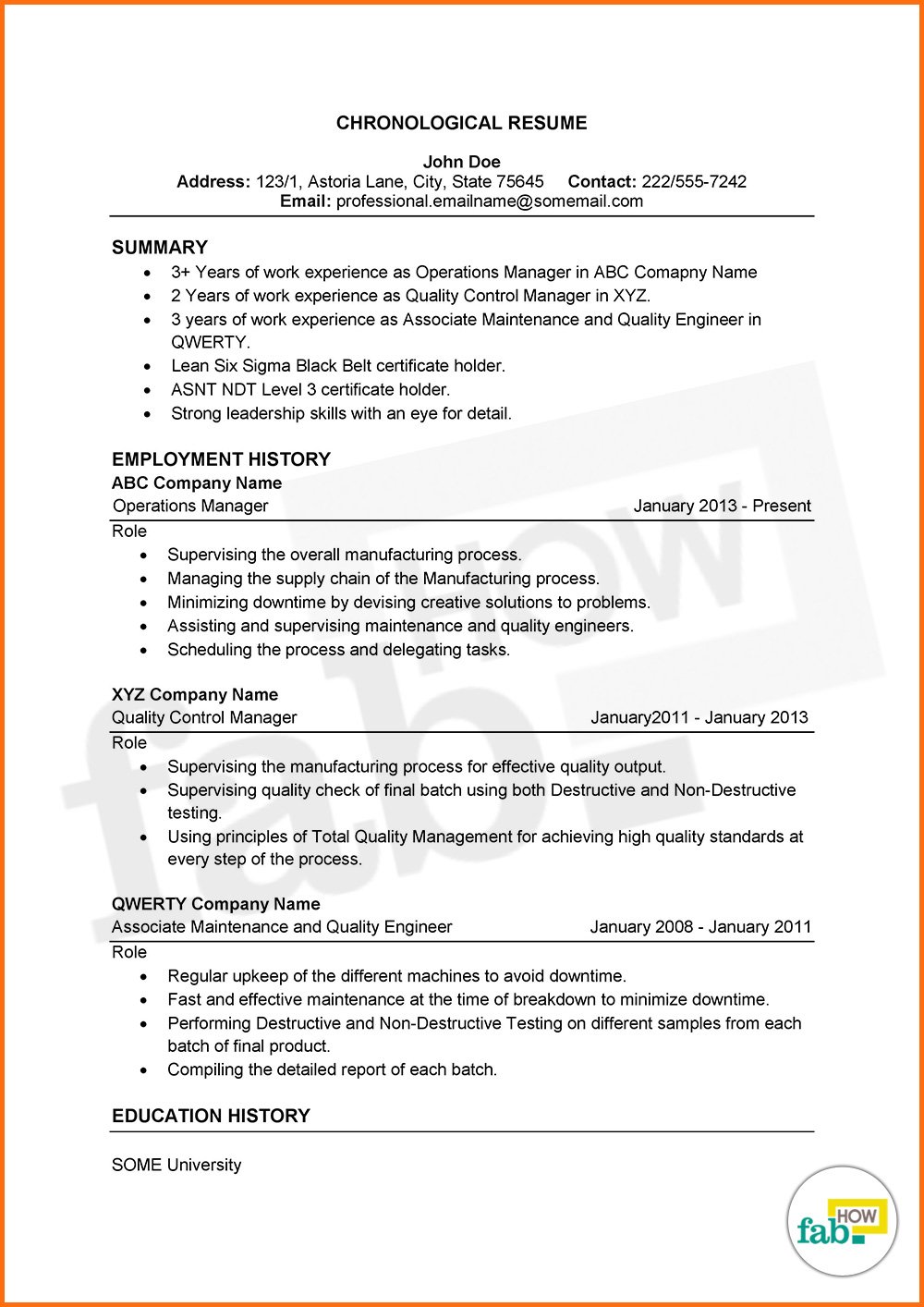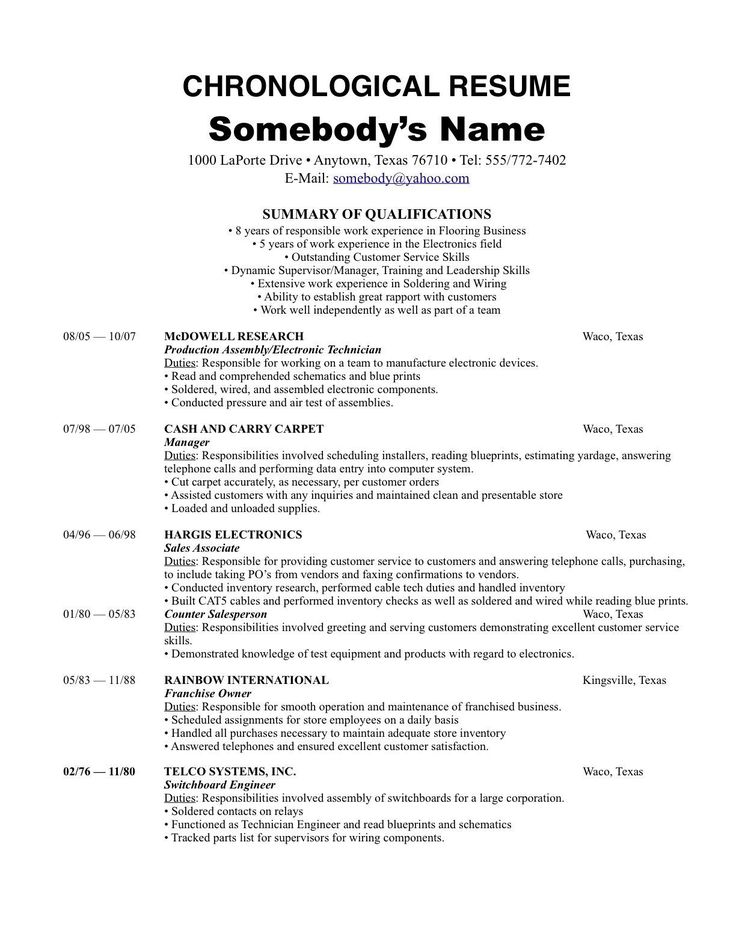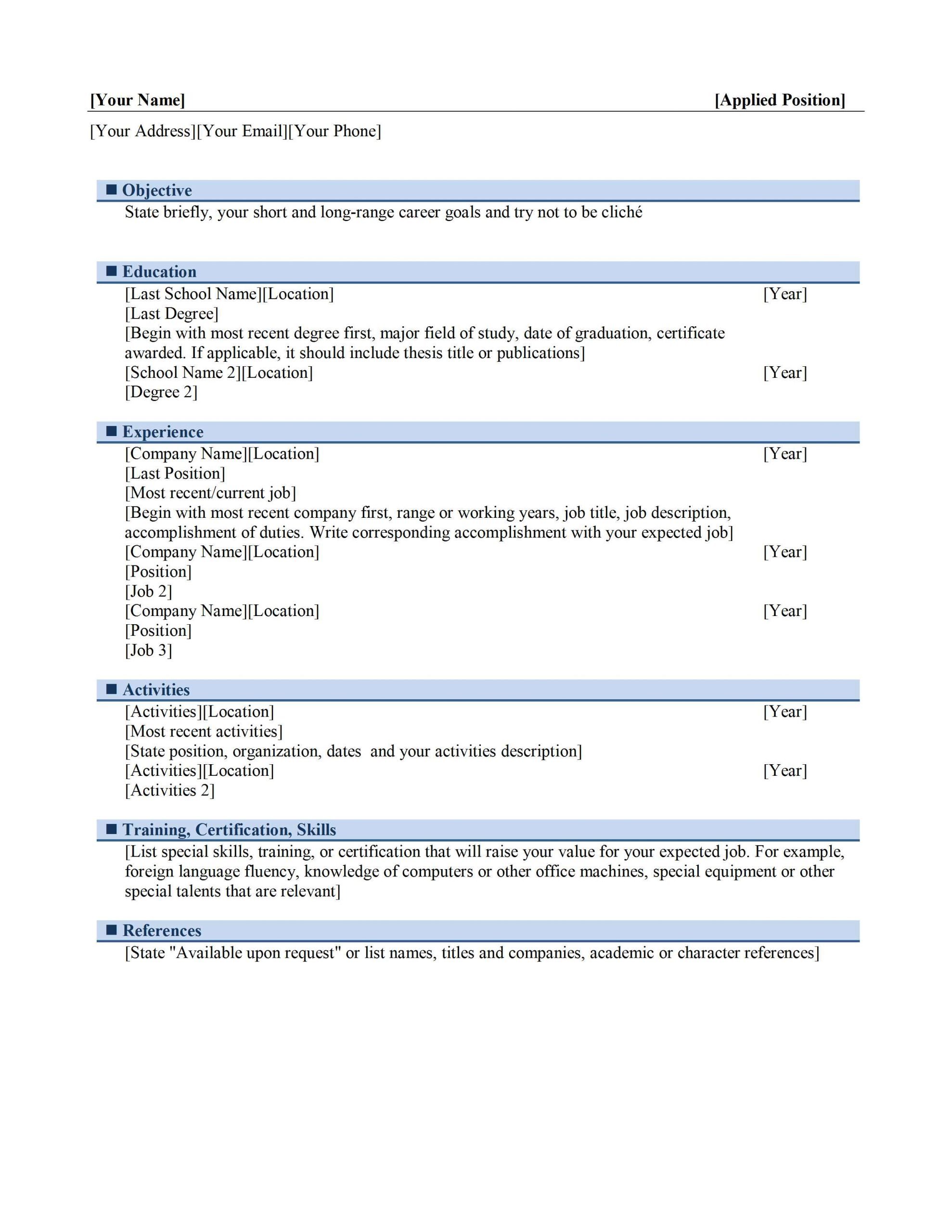Why Resumes Are Important For Job Seekers
Your resume, along with a cover letter, is an essential part of the hiring process, and is a base requirement to be considered for a position.
A good resume is the first part of your application any hiring manager will see, so its important that it conveys your qualifications accurately and convincingly.
Your resume should offer employers a digestible overview of your relevant skills, employment history, education background, and accomplishments. Based on this information, they can make an informed decision about whether or not they want to interview or hire you.
But writing a resume from scratch can be time-consuming. To simplify the process, try using our online resume builder. Just type in your information and our software will help you assemble a perfectly formatted resume that is sure to impress any hiring manager.
Whats The Difference Between Chronological Resumes And Other Resume Formats
The primary alternative to the chronological/reverse chronological resume is the functional resume format, which focuses on your experience and skills rather than a time-based narrative of how you acquired them. The hybrid resume format uses a combination of these two approaches.
For example, you may be a professional accountant who is looking for an exit strategy to pursue your longtime passion for photography. If youre preparing a resume to promote your experience doing wedding, event and real estate photography, it would make little sense to provide a detailed chronological list of your past jobs as an accountant. In this case, a functional resume emphasizing your photography experience would be a better choice.;Lets dig a little deeper into the chronological resume to see if its the best choice for you. What this guide will cover:
- When to use a chronological resume
- Advantages and disadvantages of a chronological resume
- The format and structure of;a chronological;resume
- Writing the employment history and education sections
Pros And Cons Of The Chronological Resume
Read on for the advantages and disadvantages of the chronological resume format to help you decide if this is the style of resume structure that best fits your field and professional profile.
Chronological resumes are excellent resources for job applications for candidates with an obvious vertical career path, for those who have lots of experience in a certain area or expertise in a specific field or industry and wish to progress in that same discipline.
Don’t Miss: How Much Job History On Resume
Writing The Education Section
The education section is the other part of your resume where the reverse chronological order needs to be used.
For example, if you have a Ph.D., list that first, along with the university, the field of study, and the year you earned the degree. Follow that with the same info on where you obtained your masters degree, and below that do the same for your bachelors degree.;
If you have a postsecondary degree, its generally not considered necessary to mention where you went to high school, although if you have room, it does no harm.
The education section can also be used to mention any certifications in your field, for example if you are a certified nursing assistant or a certified public accountant . Participation in job-relevant continuing education classes, seminars and workshops can also be listed here, as well as membership in honor societies, clubs or extracurricular activities related to your field. If you had a stellar grade point average or graduated with honors, you can also say so here.;
Examples Of Resumes In Reverse Chronological Order

Below are resumes that have previous work history ordered in reverse chronological order. Note that their most recent employment is at the top of their Work History or Previous Experience resume section. With a descending work history ending up with their very first job in the professional’s career at the bottom of the list.
Learn about other resume formats.
Also Check: How To Make A Resume
Are There Other Resume Formats I Can Pick
The two other typical resume formats are:
- Functional resume which focuses on skills over work history.
- Combination resume which, as the name suggests, is a hybrid of the chronological and functional resume formats.
If youd like to take a closer look at the two other options, see our dedicated guide comparing a chronological vs functional vs combination resume and make a fully-informed choice.
But , youll most likely end up with a chronological resume format anyway. And it will be for a good reason!
Now, lets walk through how you can make the most of each section of a chronological resume. Read on for tons of examples and actionable tips.;
Chronological Resume Guide: Formatting Tips And Tricks
There are many resume formats. Youve probably heard of a few of them. But the chronological resume is the most common and most popular. Thats because its the easiest to create and the easiest for recruiters and machines to read. That said, you may hear common and think boring.
Boring, in this case, isnt bad. There are lots of reasons to use a boring chronological resume. And a chronological resume doesnt have to be boring. There are plenty of ways to spice it up.
Remember, a resume is your first introduction to a potential employer. It should be easy to scan by humans or machines so they can quickly figure out if youre a potential match for the job. However, a poorly written or formatted resume will likely end you in the no way pile, even if youre the perfect person for the job.
Don’t Miss: What To Put On The Education Part Of A Resume
Definition: What Is A Chronological Resume
A chronological resume is a resume format that lists your work experience based on the dates it occurred. Working downward from the beginning of your Work Experience section, you should start listing your most recent positions first. So the top of the section will contain your current or most recent job. Below that on your resume will be your next most recent job.
This is how to write a chronological resume, which is also commonly called the reverse chronological resume. .
Third Include Work Experience In Your Resume Beginning With Your Most Recent Position
List all the companies you have worked for. Begin with your most recent position to your very first position. Indicate the duration and dates you were working for each specific employer. Be sure to use bullet points when listing your duties and responsibilities under each position. Bullets make it easy for the hiring manager to follow your resume. It is an added advantage if you try to begin each bullet point with action words, such a built,organized or consulted.
The following is an example of how your Work Experience section might look:
WORK EXPERIENCE
Pediatric Care Nurse, October 2009Present
Boston Children Hospital, Boston, MA
Duties and Responsibilities
- Giving comprehensive care to children in the intensive care unit
- Requesting for additional examinations as needed
Practical Nurse, May 2005August 2009
Duties and Responsibilities
- Helped patients with personal hygiene, dressing and bathing;
- Monitored patients and reported any serious reactions to treatment
Recommended Reading: Where Should Skills Go On A Resume
Put Your Contact Information At The Top
List the following information at the top of the page in your resume header:
- First and last name
- Email address
- Phone number
Additionally, include a link to your personal website or your LinkedIn profile.
Also note that while adding a mailing address to your resume used to be standard practice, its no longer necessary because most employers will contact you via email.
An Employment Story Worth Telling
Ultimately, a resume is the story of your work history, achievements, and skills. While its not a riveting beach read, a well-written resume can help you get an interview, which can lead to a job. Of course, like any story, a poorly written one will end up lost or forgotten about.
While you dont want your story to read like everyone elses, using a familiar format is important when youre job searching. It may not be your first choice, but it can be your best choice. Dont let flaws in your story scare you. There are plenty of resume templates that help you tell the best story possible to recruiters and can help highlight why youre the best person for the job.
Weve got more advice on how to improve your resume. And advice on how to craft an amazing cover letter so you can tell even more of your story. And, if youre looking for a little bit of guidance along the way, consider working with our career coaches who can give you tons of personal resume writing advice.
Read Also: What Is A Functional Resume Sample
What Is Reverse Chronological Order
As mentioned above, reverse chronological order means that your previous jobs are listed in order of date, beginning with your most recent position at the top. Your final entry in the list should be your oldest or least-recent position.
Note that youre not obligated to list every job on your resume! You can choose where to begin telling your career story, or whether to leave a certain job off for strategic reasons .
So Im not suggesting that you must start with the first job you ever held. However, once youve chosen a starting point for your resume work history, you should list those positions in reverse chronological order as described above.
What If I Have Gaps In Employment

Gaps on your resume are normal. It would help if you still used a reverse chronological order resume to show your employment history and experience. Don’t try to make a combination resume like some guides allude to. Just explain to your employer that you have gaps in your experience and explain the reason why.
Also Check: How To Build A Acting Resume With No Experience
Should You Use A Chronological Or Functional Resume
Too many people make the mistake of thinking that a resume’s purpose is to get them a job. Actually, resumes open and close doors. Their main purpose is to make an employer interested enough to invite you in for an interview.
But how do you create that interest when you don’t exactly fit the mold? Just as people come in different sizes and shapes, so do resumes.
Chronological Resumes
The chronological resume seems to be the most popular format used. This type of resume usually contains an objective and/or summary statement and a chronological listing of all your employers along with related accomplishments. Educational information is included along with certifications and special skills.
This type of resume may be fine for someone who is experienced, but if you are switching careers or are just entering the workforce, this type of resume will most likely help you wind up in the “no” pile. So how do you showcase your talents if you can’t lay them out like everyone else?
Functional Resumes
Take the time to develop a strong functional resume. Functional resumes highlight your abilities, such as hiring, managing or coaching, rather than your chronological work history. You’ll still need to summarize your work history, but this is usually done at the bottom of your resume. Don’t panic. By the time the reader has gotten to that point, he is usually sold on bringing you in for an interview.
Who Should Use a Functional Resume?
Describe Your Work Experience To Show Youll Do The Job Well
Here comes the key component of every reverse-chronological resume template.
The work history section. Its the most prominent part of the whole resume. One that makes or breaks your chances.
Heres how to craft a millennium-falcon-like experience section on a chronological resume:
- Start with your current or most recent position, then follow it with the one before it, then the previous one, and so on.
- Limit yourself to up to 15 years of professional experience. Leave off all positions older than that.
- In every entry, include your job title, company name, dates worked, and up to 6 bullet points detailing your duties and achievements.
Alright, lets see a good and a bad example of presenting your work history in a reverse-chronological resume layout.
Work experience on a chronological resume: examples
Heres a top-notch work history section sample taken from a resume of a data scientist.;
The job to which shes applying requires skills in machine learning, data mining, and model development optimization.;
You May Like: Should You Include Your Address On Your Resume
Housekeeping Rules That Apply To All Formats:
The Structure And Format Of A Chronological Cv
A chronological resume should follow this basic structure and format:
;Header: Contains your name, occupation, address, email and phone number.; Summary/profile: 3-4 lines at the top of the page summarizing what you do and why youre good at it. Employment history: A listing of your past jobs , with bullet points on what you achieved at each one. Education: Your formal educational experience and any certifications in your field. Skills: A short list of the hard and soft skills that make you good at your job. Optional sections: Membership in professional organizations; hobbies and interests; references
Here is how a chronological resume should look.
You May Like: How Many Pages Should A Resume Be 2020
How To Write A Chronological Resume
Your resume should include information relevant to the position for which youre applying. Chronological resume sections should include the following in this order:
- Name and contact information
- Educational history
- Skills and abilities
You can also include achievements and interests, but these should only be included at the end of your resume, and only if they are relevant. If your resume is multiple pages, consider removing optional sections like these to make it as brief, concise and readable as possible.
The key difference between a chronological resume and other formats is how you structure your experience section. In this format, you will list your most recent experience first. When you are writing the details of each experience, you should reference the job descriptions that interest you to see which keywords employers are using. These terms can be a guide for what phrases to include when you describe your own experiences.
The placement of your professional experience and education sections depends on where you are in your career and the relevance of education to your chosen industry.
For example, if you are writing a resume as a student, you may want to prioritize your education section as it may be more helpful information for potential employers. This is especially true if you have relevant certifications, diplomas or coursework. If you have been in the workforce for several years, you might consider placing your education after your experience section.
When To Consider A Different Type Of Resume
Some employers prefer a Cv, a functional resume, or a combination resume. If you are not certain which type of resume will yield the best results, contact the hiring manager and ask which type of resume the company prefers to receive. In addition, consider using a different type of resume in the following situations:
- Youve job-hopped a lot. Whether by chance or by choice, job-hopping often leaves a negative impression on hiring managers. Consider using a functional resume if you have a history of jumping from one job to another.
- Youve changed career tracks multiple times. If you have tried different jobs out for size and changed career tracks more than once, its likely that you have many skills employers will find appealing. Highlight skill and minimize career change by using a functional or combination resume.
- You want to transition into a completely new career. If you have desirable skills, certification, or education and want to make a career change, a functional resume that places a large amount of emphasis on these aspects will prove more attractive than a chronological resume that focuses on unrelated positions youve held in the past.
- You dont fit the mold. If youre not sure that your past history will help you obtain the job youre applying for, listen to your intuition and pick a different type of resume. Consider using a functional resume that highlights transferable skills youve acquired. This will improve your chances of winning an interview.
Don’t Miss: Where To Put Relevant Coursework On A Resume
Chronological Resume Tips And Examples
There are several resume formats you can use to present information to employers. The chronological resume format, also known as reverse-chronological, lists your professional experience from most to least recent.
This format is best used by those with a consistent work history and increasing job levels over time. If you have significant gaps in your career or have changed industries or positions multiple times, you might consider using a functional or combination resume format.
1. Name and contact information2. Summary or objective5. Skills and abilities
If You Held Multiple Roles Within A Company Show Each Job Title Separately On Your Resume

This is important so that employers can see that you advanced/progressed in the company. Recruiters typically love this!
Heres another example of a chronological resume, where you can see two distinct job titles listed under one single employer. This person was promoted from Sales Rep to Branch Manager.
You May Like: What Is A Good Typing Speed For Resume